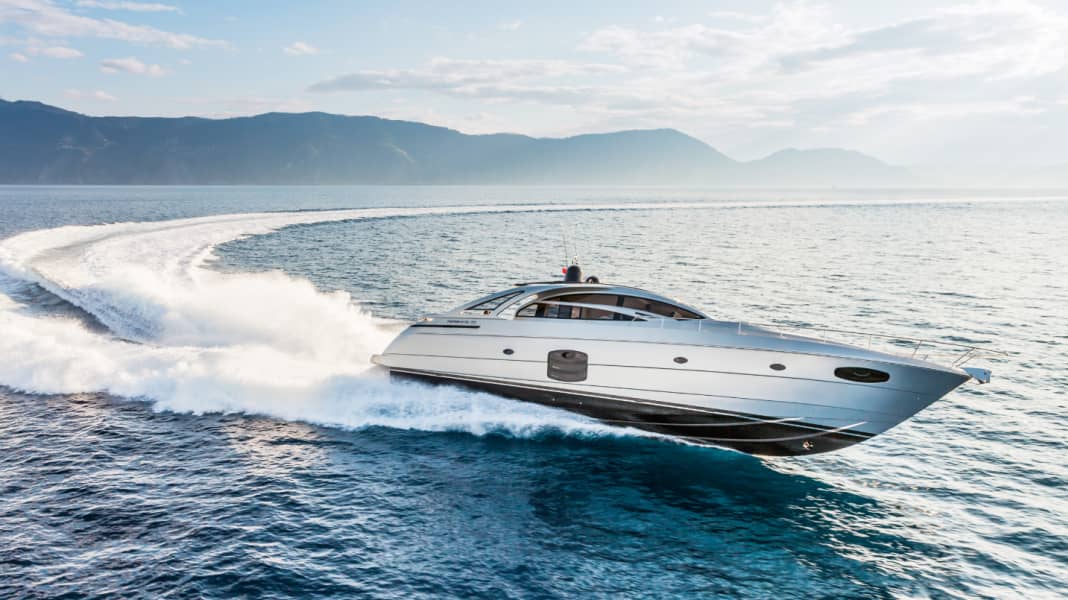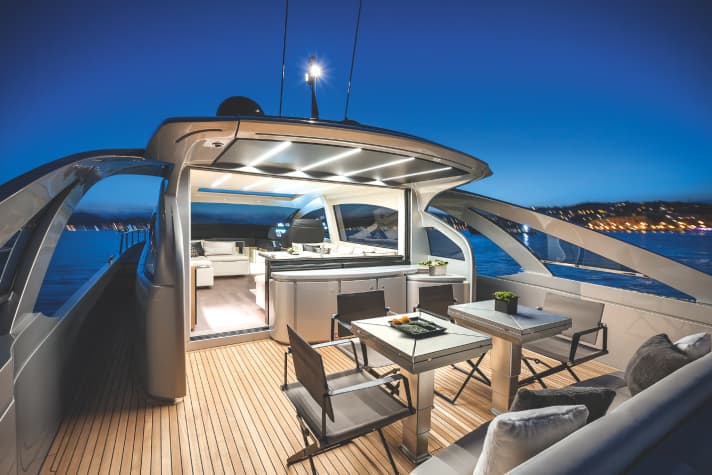
Pershing has been part of the Ferretti Group for years. And as is usual with any renowned company, there is also a sports department here. From the very beginning, its focus has been on speed, good looks, the best possible quality and a good measure of luxury.

All of this has been realised under the Pershing name since the company was founded in 1985. Although it started small, the company now operates exclusively in the luxury class and builds boats from 50 feet to over 100 feet in length (16 to 35 metres). One of these is our test boat, the Pershing 70, which is available with two or three cabins, the same number of bathrooms plus a cabin and bathroom for the crew.
>>> The characteristic feature of these drives is their water tail, the so-calledrooster tail or rooster tail, which is visible behind the boat at full speed.
Like all Pershings, our test boat is also equipped with surface drives. Pershing relies solely on Arneson. These and all other surface drives have the advantage that they are not so deep in the water and are therefore inherently faster than conventional drives. The lower resistance makes all the difference. The characteristic feature of these drives is their water tail, the so-calledrooster tail or rooster tail, which is visible behind the boat at full speed.
This is because the propeller blades partially protrude out of the water and throw the water backwards, which is visible from afar. For effective utilisation of the propulsive force, these drives always occur in pairs, as the lateral force generated by the propellers is approximately equal to their propulsive force. To compensate for the lateral forces, a double installation with clockwise and anti-clockwise rotating propellers is mandatory.
Our test boat is equipped with two 10-cylinder diesel engines from MTU, each with a displacement of 22.3 litres and a combined output of 3246 hp on the propeller shafts. These in turn are converted into propulsion by two powerful Rolla propellers.
>>> The transition takes place within 200 revolutions per minute and is accompanied by a sudden increase in speed
Pershing does not tell us their dimensions because, so the argument goes, the competition is reading. We have used our calculator and calculated that the propeller diameters must be larger than 100 cm and the pitches at least 150 cm. If we now look at the propeller efficiency and how it is implemented, the boat should theoretically travel at just over 12 knots at the lowest engine speed (630 rpm). We measured 8 knots. However, if you look at the values at full throttle (2450 rpm), the difference between the theoretical speed (47.4 knots) and the measured speed (47 knots) is not even half a knot.
There are four options for slow driving: With both drives or one normally ahead, or with the two switchable programmes Trolling 1 and 2 on the switch box. With Trolling 1, the gearbox output speeds are reduced by 25 percent and with Trolling 2 by 50 percent. This means travelling at 6 knots in the first case and 4 knots in the second.
The transition from displacement to planing speed happens quite quickly on the Pershing 70 and without it trimming too much. The transition takes place within 200 rpm and is felt to be associated with a sudden increase in speed, i.e. up to 12 kn or 1400 rpm as a displacer, from 1600 rpm or 22 kn as a glider. From that point onwards, the speed is only impetuous.
Starting with surface drives is handled differently to Z-drives. While sterndrives are trimmed completely, surface drives are trimmed close to the water surface. Unlike conventional propellers, they need air. And that makes the whole thing a little difficult for those who don't use them every day. But Pershing has installed a perfectly functioning automatic trimming system that makes it easy even for the inexperienced driver.
>>>Take only the best! The result: a noble driving machine
The automatic trim system also includes control of the trim tabs. Otherwise you would have to struggle with four joysticks plus two throttle levers and watch out for traffic. Regardless of this, the conventional rudder is almost only of symbolic value, as the boat is also steered using a joystick.
Too much automation? On the contrary! Once the boat has picked up speed, the real fun begins: you use your thumb and index finger to determine where to go. And it's really fun when you thread the Pershing 70 precisely and accurately between the marker poles in the Adriatic. The diameter of the turns is a question of speed; at full speed, you're at around 500 metres. You also don't realise that you're travelling with a mass of around 45,000 kg, and you only notice the speed at the control stand if you watch the instruments.
This changes when you step out into the cockpit. While you don't notice the wind too much in the centre of the cockpit and on the large sunbed thanks to the wings above the side decks, it blows towards you at full gale force on the side decks. The fact that we are dealing with a sports boat can also be seen from the shipyard data, in which the cruising speed of the Pershing 70 is stated as 40 kn at 2200 rpm.
Our measurement results show that you can already travel "economically" at 36 kn at 2000 rpm and the 3500 litre tank filling is sufficient for a theoretical range of 250 nm plus 15% reserve. This is not enough for us and means that you have to plan refuelling stops well or travel in displacement.
In terms of the overall workmanship in, on and around the boat, there is not the slightest thing to criticise. Our verdict: top class.

